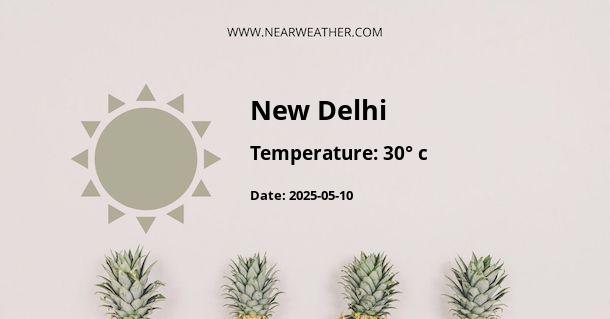Climate and Weather in New Delhi, India
New Delhi, the capital city of India, experiences a semi-arid climate characterized by extremely hot summers and cool winters. The city's location in the northern part of the country, along with its proximity to the Thar Desert, plays a significant role in shaping its weather patterns throughout the year. Let's explore the climate and weather conditions in New Delhi in more detail.
Temperature
Summers in New Delhi are scorching, with temperatures often soaring above 40 degrees Celsius (104 degrees Fahrenheit). The months of May and June are the hottest, with average daily maximum temperatures reaching around 42 degrees Celsius (108 degrees Fahrenheit). The intense heat is accompanied by very low humidity levels, making it feel even hotter.
Winter in New Delhi, on the other hand, is relatively chilly but not excessively cold. The months of December and January are the coldest, with average daily minimum temperatures dropping to around 7 degrees Celsius (45 degrees Fahrenheit). However, during the day, temperatures can still reach a comfortable 20 degrees Celsius (68 degrees Fahrenheit).
Spring and autumn are transitional seasons in New Delhi, with mild temperatures that range between 15-30 degrees Celsius (59-86 degrees Fahrenheit). These seasons provide a pleasant break from the extremes of summer and winter.
Rainfall
New Delhi experiences a monsoon-influenced climate, with the majority of its annual rainfall occurring during the summer months. The monsoon season typically starts in late June and lasts until September. During this period, the city receives heavy rainfall, often in the form of intense thunderstorms.
The monsoon showers bring much-needed relief from the sweltering heat, but they can also result in waterlogging and occasional flooding in low-lying areas. The average annual rainfall in New Delhi is around 700 millimeters (27.6 inches), with July and August being the wettest months.
Wind Patterns
During the summer months, New Delhi experiences hot and dry winds known as "loo." These winds blow from the northwest and can significantly increase the temperature, making the weather even more uncomfortable. The loo winds can reach speeds of up to 35-40 kilometers per hour (22-25 miles per hour).
In contrast, during the monsoon season, New Delhi experiences a shift in wind direction. Moisture-laden winds from the Arabian Sea and the Bay of Bengal bring in the much-needed rain and provide relief from the heat. These winds generally blow from the southwest and are responsible for the heavy downpours that occur during this time.
Fog and Smog
Winter in New Delhi is notorious for its foggy conditions, often caused by the combination of cool temperatures and high levels of air pollution. The dense fog can disrupt air and road transport, leading to delays and cancellations. It is advisable to check the weather conditions and take necessary precautions while traveling during the winter months.
Additionally, New Delhi faces a persistent problem of smog, particularly during the winter season. The combination of vehicular emissions, industrial pollution, and agricultural burning results in poor air quality, causing health issues for residents. It is important to stay informed about the air quality index and take necessary measures to protect oneself from the harmful effects of smog.
Extreme Weather Events
Although New Delhi does not experience extreme weather events like hurricanes or tornadoes, it is prone to dust storms and heatwaves. Dust storms, known as "haboobs," are common during the summer months when hot winds from the Thar Desert carry large amounts of dust and sand, reducing visibility and creating hazardous conditions.
Heatwaves are also a significant concern in New Delhi, especially during the summer months. The combination of high temperatures, low humidity, and heat-trapping urban environments can create dangerous conditions for the city's residents. It is crucial to stay hydrated, avoid prolonged exposure to the sun, and take necessary precautions during such extreme weather events.
Conclusion
In conclusion, New Delhi experiences a semi-arid climate with extremely hot summers and cool winters. The city's proximity to the Thar Desert influences its weather patterns, resulting in scorching temperatures during the summer and relatively mild winters. The monsoon season brings much-needed rainfall and relief from the heat, but it can also lead to waterlogging and flooding. It is important to stay informed about the weather conditions, particularly during the summer months, and take necessary precautions to ensure personal safety and well-being.
A - New Delhi's Latitude is 28.612820 & Longitude is 77.231140.
A - Weather in New Delhi is 10° today.
A - Climate Conditions in New Delhi shows fog today.
A - Humidity in New Delhi is 93% today.
A - Wind speed in New Delhi is 3.71 km/h, flowing at 270° wind direction. today.
